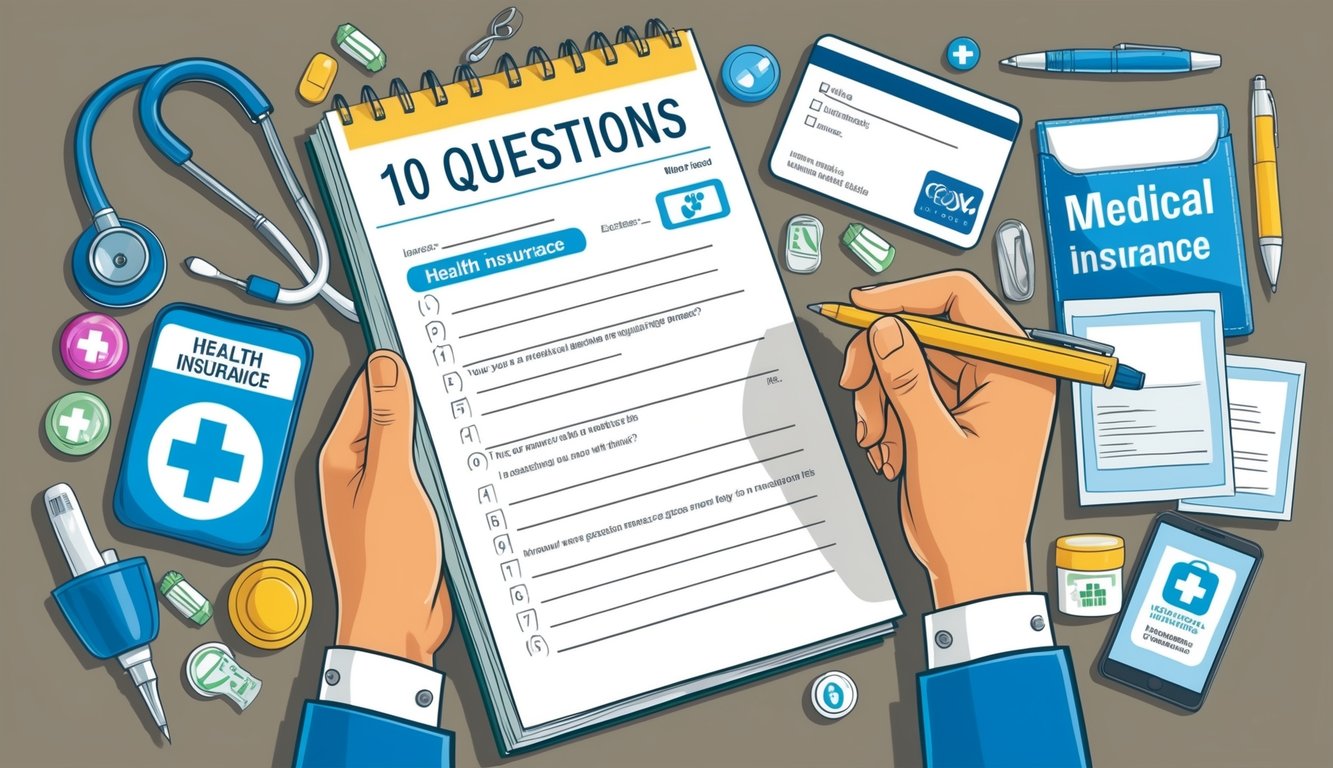Choosing the right health insurance plan is a crucial decision that can significantly impact your financial well-being and access to healthcare.
With numerous options available, it’s essential to approach this task with careful consideration and thorough research.
Asking the right questions before purchasing health insurance can help you make an informed decision that aligns with your specific needs and budget. By evaluating various aspects of potential plans, you can gain a clearer understanding of what each option offers and how it may affect your healthcare experience.
Taking the time to ask important questions can help you avoid unexpected costs and ensure you select a plan that provides adequate coverage for your medical requirements.
1) What is the policy coverage?
When selecting health insurance, understanding the policy coverage is crucial.
You should ask about the specific medical services and treatments included in the plan.
Inquire about coverage for preventive care, such as annual check-ups, vaccinations, and screenings.
These services are often covered at no additional cost under many plans.
Ask about coverage for prescription medications.
Some plans may have a separate deductible for prescriptions or limit coverage to specific drugs.
Check the scope of services provided by the plan.
This includes coverage for specialist visits, hospital stays, emergency care, and mental health services.
Find out if the plan covers alternative treatments like acupuncture or chiropractic care if these are important to you.
Ask about coverage for maternity care, fertility treatments, or pediatric services if applicable to your situation.
Inquire about coverage for durable medical equipment, such as wheelchairs or oxygen tanks, if you anticipate needing these items.
Determine if there are any exclusions or limitations in the policy.
Some plans may not cover certain procedures or have waiting periods for specific treatments.
Ask about coverage for pre-existing conditions to ensure your current health needs will be met.
2) Are pre-existing conditions covered?

When shopping for health insurance, it’s crucial to understand how pre-existing conditions are handled.
A pre-existing condition is a health problem you had before the date that new health coverage starts.
Good news: thanks to the Affordable Care Act, health insurance companies cannot deny you coverage or charge you more based on pre-existing conditions.
This applies to plans that started on or after January 1, 2014.
Common pre-existing conditions include diabetes, asthma, and cancer. Pregnancy is also considered a pre-existing condition, but it’s covered as soon as your plan starts.
When reviewing potential health insurance plans, ask the provider about any waiting periods or limitations for pre-existing conditions.
While they can’t deny coverage, some plans might have specific rules about when certain treatments can begin.
It’s important to disclose all your health conditions when applying for insurance.
Being transparent ensures you fully understand your coverage and can make an informed decision about which plan best suits your needs.
Remember, your health history shouldn’t be a barrier to obtaining comprehensive insurance coverage.
The right plan will provide the protection you need, regardless of pre-existing conditions.
3) What is the premium cost?

The premium cost is a crucial factor to consider when choosing health insurance.
It’s the amount you’ll pay regularly to maintain your coverage, typically on a monthly basis.
Premium costs can vary widely depending on several factors.
These may include your age, location, smoking status, and the level of coverage you select.
When evaluating premium costs, it’s important to look beyond just the monthly amount.
Consider how the premium fits into your overall budget and healthcare needs.
Keep in mind that lower premiums often come with higher out-of-pocket costs when you actually use medical services.
Conversely, higher premiums generally mean lower costs when you receive care.
It’s wise to compare premium costs across different plans and insurance providers.
This can help you find the best balance between affordability and coverage for your specific situation.
Remember that premium costs may change from year to year.
Be prepared to reassess your options during open enrollment periods to ensure your plan still meets your needs and budget.
4) What is the deductible amount?
The deductible is the amount you pay for covered health care services before your insurance plan starts to pay.
It’s a crucial factor in determining your out-of-pocket costs.
Deductible amounts vary by plan, ranging from a few hundred to several thousand dollars.
For example, in 2022, the maximum deductible for Qualified Health Plans was $8,700 for individuals and $17,100 for families.
When choosing a plan, consider how the deductible fits your budget and health needs.
A higher deductible often means lower monthly premiums, while a lower deductible typically results in higher premiums.
Be aware that some plans have separate deductibles for different types of services, such as medical care and prescription drugs. Once you’ve met your deductible, you usually pay only a copay or coinsurance for covered services.
It’s important to note that your deductible resets every year, even if your expenses exceeded it in the previous year.
This means you’ll need to meet the deductible again before your insurance starts covering costs.
Some preventive services, like annual check-ups or vaccinations, may be covered without having to meet your deductible.
Always check your plan details to understand what’s included.
5) Are out-of-network costs covered?
When choosing a health insurance plan, it’s crucial to understand how out-of-network costs are handled.
Out-of-network providers are those not contracted with your insurance company.
Many plans offer limited or no coverage for out-of-network care, which can lead to significant expenses if you need treatment from these providers.
Ask your potential insurer about their policies regarding out-of-network coverage.
Some plans may cover a percentage of out-of-network costs, while others might not cover them at all.
Be aware that out-of-network charges can add up quickly.
It’s important to familiarize yourself with your plan’s specifics to avoid unexpected bills.
Consider your healthcare needs and preferences.
If you have a preferred specialist who isn’t in-network, you might want a plan with more flexible out-of-network coverage.
Some insurers may allow you to request coverage for out-of-network care at in-network rates in certain situations.
Ask about this option and the process for making such requests.
6) What is the co-payment?
A co-payment, often called a copay, is a fixed amount you pay for specific healthcare services under your insurance plan.
It’s typically a small fee, usually less than $30, that you’re required to pay at the time of service.
Copays can vary depending on the type of service you receive and your specific health insurance plan.
For example, you might have a $20 copay for a regular doctor’s visit, but a $50 copay for a specialist appointment.
It’s important to understand that copays are separate from your deductible.
You’ll need to pay your copay even if you haven’t met your deductible yet.
When considering a health insurance plan, ask about the copay amounts for different services.
This includes primary care visits, specialist visits, emergency room visits, and prescription medications.
Keep in mind that some preventive services, like annual check-ups, may not require a copay under many plans.
Understanding your copay structure can help you budget for healthcare expenses and choose a plan that best fits your needs.
Remember, lower copays often mean higher monthly premiums, while higher copays typically result in lower premiums.
Consider your healthcare needs and financial situation when evaluating copay amounts in different plans.
7) Does it cover prescription drugs?

Prescription drug coverage is a crucial aspect of health insurance.
You should carefully review the policy details to understand what medications are covered and at what cost.
Many health insurance plans include prescription drug coverage, but the extent can vary significantly.
Some plans may cover only generic drugs, while others include both generic and brand-name medications.
Check if your current medications are on the plan’s formulary, which is a list of covered drugs.
The formulary typically categorizes drugs into tiers, with lower tiers having lower out-of-pocket costs.
Be aware of any prior authorization requirements for certain medications.
This means your doctor must get approval from the insurance company before prescribing specific drugs.
Look into the copayments or coinsurance for different types of medications.
These costs can add up, especially if you take multiple prescriptions regularly.
Consider if the plan offers mail-order pharmacy services.
This option can often provide cost savings and convenience for long-term medications.
If a medication you need isn’t covered, ask about the process for requesting an exception or filing an appeal.
Some insurers may cover non-formulary drugs under certain circumstances.
8) Is there a lifetime maximum payout?

A lifetime maximum payout is the total amount an insurance company will pay for your healthcare over your lifetime.
It’s crucial to understand if your potential health insurance plan has this limit.
In the past, many insurance policies included lifetime maximums.
However, the Affordable Care Act changed this for essential health benefits.
For non-essential services, some plans may still have lifetime maximums.
It’s important to ask about these limits and understand what they cover.
If a plan does have a lifetime maximum, find out the specific amount.
Consider whether it would be sufficient for potential long-term health issues.
Be aware that reaching a lifetime maximum could leave you without coverage for certain services.
This could potentially lead to significant out-of-pocket expenses.
When comparing plans, look for those with higher lifetime maximums or no maximum at all.
These may offer better long-term protection, especially if you have ongoing health concerns.
9) How is the claim process?

Understanding the claim process is crucial when selecting health insurance.
You should inquire about the steps involved in filing a claim with your potential insurer.
Ask if the insurance company offers a dedicated insurance desk at network hospitals.
This can simplify the claim process during medical emergencies.
Find out if you need to file claims yourself or if your healthcare provider handles it.
Many doctors’ offices submit claims electronically, which can speed up the process.
Inquire about the timeframe for claim processing and reimbursement.
Knowing how long it typically takes can help you plan your finances accordingly.
Ask about the documentation required for filing a claim.
Having this information in advance can help you prepare and avoid delays.
Find out if there’s an online portal or mobile app for tracking claim status.
This can provide convenience and peace of mind as you await claim resolution.
Lastly, ask about the appeal process for denied claims.
Understanding your options if a claim is rejected can be valuable in the long run.
10) Are preventive services included?

Preventive services are an essential part of maintaining good health.
When shopping for health insurance, it’s crucial to ask if these services are included in your plan.
Most health plans are required to cover preventive services at no cost to you.
This means you won’t have to pay deductibles, copayments, or coinsurance for these services when delivered by in-network providers.
Preventive care typically includes annual physical exams, vaccines, and recommended cancer screenings.
These services can help detect health issues early, potentially saving you money on more expensive treatments down the line.
Ask your potential insurer for a list of covered preventive services.
This list may include well-baby and well-child visits, various health screenings, and certain vaccinations.
It’s important to note that while these services are often described as “free,” their cost is factored into your premium rates.
However, accessing preventive care without additional out-of-pocket expenses can make it easier for you to prioritize your health.
Remember to inquire about any limitations or specific conditions for accessing these services.
Some plans may require you to use specific providers or facilities to receive full coverage for preventive care.
Understanding Health Insurance Terms
Health insurance terminology can be confusing.
Knowing key terms and plan types will help you make informed decisions about your coverage.
Premiums and Deductibles Explained
Your premium is the amount you pay monthly for health insurance coverage.
It’s a fixed cost you’ll pay regardless of whether you use medical services.
Deductibles are the amount you must pay out-of-pocket for covered services before your insurance starts to pay.
Higher deductibles often mean lower premiums, and vice versa.
For example, with a $1,000 deductible, you’ll pay the first $1,000 of covered medical costs.
After meeting your deductible, you’ll typically pay a percentage of costs (coinsurance) or a fixed amount (copay) for services.
Some plans offer preventive care services without requiring you to meet your deductible first.
Differences Between HMO, PPO, and EPO Plans
HMO (Health Maintenance Organization) plans typically have lower premiums but require you to choose a primary care physician (PCP) and get referrals for specialists.
PPO (Preferred Provider Organization) plans offer more flexibility.
You can see specialists without referrals and use out-of-network providers, though at a higher cost.
EPO (Exclusive Provider Organization) plans combine features of HMOs and PPOs.
They usually don’t require referrals but limit coverage to in-network providers except in emergencies.
Consider your healthcare needs and budget when choosing between plan types.
HMOs may be cost-effective if you don’t mind a more restricted network.
In-Network vs. Out-Of-Network Providers
In-network providers have negotiated rates with your insurance company.
Using these providers typically results in lower out-of-pocket costs for you.
Out-of-network providers haven’t agreed to discounted rates with your insurer.
You’ll usually pay more when using these providers, and some plans may not cover out-of-network care at all.
Always check if your preferred doctors and hospitals are in-network before choosing a plan.
Remember that network status can change, so verify periodically.
Some plans, like PPOs, offer partial coverage for out-of-network care.
Others, like HMOs, generally don’t cover out-of-network care except in emergencies.
Evaluating Coverage Requirements
Assessing your current health needs and considering potential future scenarios are crucial steps in choosing the right health insurance plan.
These evaluations help ensure your coverage aligns with your medical requirements and financial situation.
Assessing Your Current Health Needs
Start by reviewing your medical history and ongoing health conditions.
Make a list of any prescription medications you take regularly.
Then, consider how often you visit doctors or specialists.
Evaluate your typical healthcare usage over the past year.
Do you require frequent doctor visits or have a chronic condition that needs regular management?
Check the scope of services offered by potential plans.
Ensure they cover your essential needs, such as specific medications or treatments.
Look at the network of healthcare providers.
Are your preferred doctors and hospitals included? If not, weigh the costs of going out-of-network against switching to in-network providers.
Considering Future Health Scenarios
Think about potential life changes in the coming year.
Are you planning to start a family? This might require maternity coverage and pediatric care.
Consider your family history.
Are you at higher risk for certain conditions? Look for plans that offer comprehensive coverage in those areas.
Evaluate your lifestyle and any planned activities.
If you enjoy extreme sports, you might want a plan with good emergency and orthopedic coverage.
Review the plan categories (Bronze, Silver, Gold, Platinum) to understand how costs are shared.
Higher-tier plans typically have higher premiums but lower out-of-pocket costs.
Consider your financial situation.
Can you afford higher premiums for more comprehensive coverage, or would you prefer lower premiums with higher out-of-pocket costs?
Financial Aspects and Hidden Costs
When selecting health insurance, it’s crucial to understand the financial implications beyond the monthly premium.
Examining out-of-pocket costs and potential hidden expenses can help you make an informed decision.
Out-Of-Pocket Maximums
Your out-of-pocket maximum is the most you’ll pay for covered services in a year.
Once you reach this limit, your insurance covers 100% of eligible expenses.
It’s essential to consider this amount when budgeting for healthcare costs.
Lower maximums offer more protection against high medical bills but often come with higher premiums.
Review your plan’s coverage details carefully.
Some services may not count towards your out-of-pocket maximum, potentially leaving you with unexpected costs.
Co-Payments and Co-Insurance
You pay fixed amounts for specific services with co-payments.
Meanwhile, co-insurance is a percentage of the cost that you share with your insurer.
Understanding these costs helps you predict your expenses for common medical services.
For example:
- Office visits: $20-$50 co-pay
- Specialist visits: $30-$75 co-pay
- Emergency room: $100-$300 co-pay
- Prescription drugs: Tiered co-pays ($10/$25/$50)
Co-insurance typically ranges from 10% to 30% of the service cost.
Remember, you’ll pay these amounts until you reach your out-of-pocket maximum.






